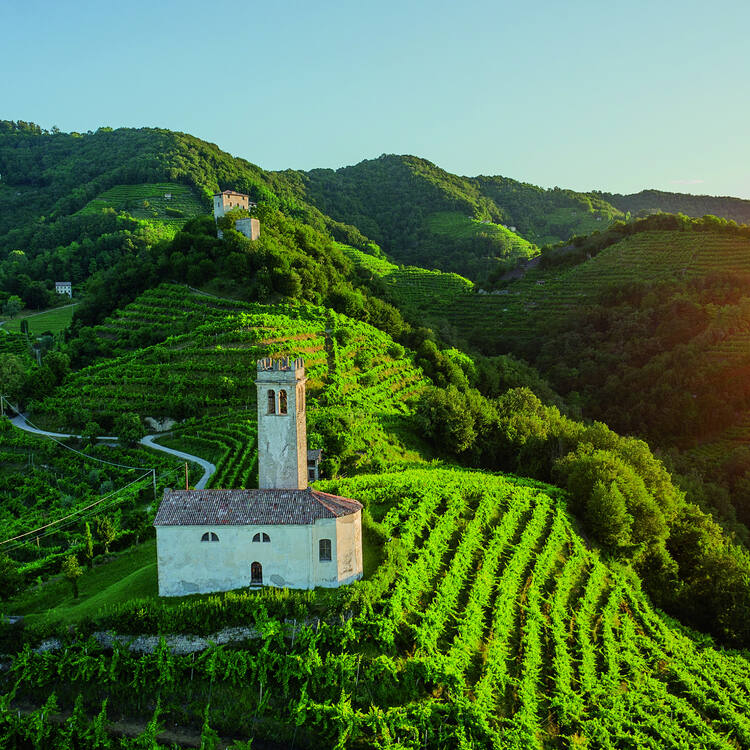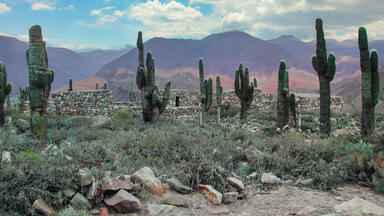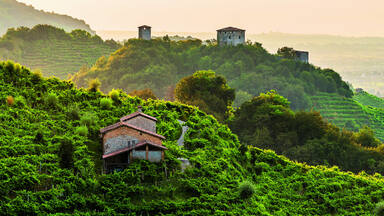Le Colline del Prosecco di Conegliano e Valdobbiadene
Le Colline del Prosecco di Conegliano e Valdobbiadene
Located in north-eastern Italy, the property includes part of the winegrowing landscape of the Prosecco wine production area. The landscape is characterized by ‘hogback’ hills, ciglioni – small plots of vines on narrow grassy terraces – forests, small villages and farmland. For centuries, this rugged terrain has been shaped and adapted by man. Since the 17th century, the use of ciglioni has created a particular chequerboard landscape consisting of rows of vines parallel and vertical to the slopes. In the 19th century, the bellussera technique of training the vines contributed to the aesthetic characteristics of the landscape.Description is available under license CC-BY-SA IGO 3.0
Les Collines du Prosecco de Conegliano et Valdobbiadene
Le bien, qui se trouve dans le nord-est de l’Italie, comprend une partie du paysage viticole de la zone de production du vin Prosecco. Ce paysage se caractérise par des collines aux pentes abruptes, des petites parcelles de vignes installées sur des terrasses herbeuses et étroites, les ciglioni, des forêts, des petits villages et des terres agricoles. Pendant des siècles, ce terrain accidenté a été façonné et adapté par l’homme. L’utilisation des ciglioni a créé depuis le XVIIe siècle un paysage en mosaïque unique, constitué de rangs de vignes parallèles et verticaux par rapport aux pentes. Au XIXe siècle, la technique de treillage des vignes, appelée bellussera, a contribué aux caractéristiques esthétiques de ce paysage.Description is available under license CC-BY-SA IGO 3.0
<تلال بروسيكو دي كونجليانو وفالدوبياديني
تقع هذه التلال شمال شرق إيطاليا، وتضم جزءاً من المناظر الطبيعية لإنتاج النبيذ في منطقة بروسيكو. وتتميز هذه المناظر الطبيعية بالتلال ذات المنحدرات الحادة والمساحات الصغيرة من الكروم في المدرجات الزراعية والضيقة، وذلك إلى جانب الغابات والقرى الصغيرة والأراضي الزراعية. وقذ تشكلت هذه التضاريس الوعرة على مدار قرون طويلة وتكيّف الإنسان مع الظروف فيها. ويعدّ استخدام هذه التلال منذ القرن السابع عشر، منظراً طبيعياً مكوناً من صفوف من الكروم المتوازية والعمودية على المنحدرات. وقد أسهمت تقنية تعريشة الكروم في القرن التاسع عشر، والمسماة أيضاً "بيلوسيرا"، في تشكّل الخصائص الجمالية لهذا الموقع.
source: UNESCO/CPE
Description is available under license CC-BY-SA IGO 3.0
科内利亚诺和瓦尔多比亚德内的普罗赛柯产地
该遗产位于意大利东北部,并包含部分普罗赛柯酒产地的葡萄园。当地的典型景观包括猪背岭、山坡上狭小的多草葡萄园、森林、小型村庄和农田。这片崎岖的土地历经人类几百年的开垦和改造。自17世纪以来,与山坡走向平行或垂直的狭窄葡萄园形成了独特的棋盘型景观。19世纪采用的“贝罗塞拉”葡萄栽培技术进一步丰富了当地景观的美学特征。
source: UNESCO/CPE
Description is available under license CC-BY-SA IGO 3.0
Холмы Просекко в Конельяно и Вальдоббьядене
Этот объект, расположенный на северо-востоке Италии, включает часть винодельческого ландшафта района производства вина Просекко. Местный ландшафт характеризуется холмами с крутыми склонами, небольшими виноградниками ciglioni на узких травянистых террасах, лесами, сельскохозяйственными угодьями и небольшими деревнями. На протяжении веков эта пересеченная местность формировалась под влиянием человеческой деятельности. Начиная с XVII века использование ciglioni создало особый мозаичный ландшафт с параллельно и перпендикулярно расположенными по отношению к холмам виноградниками. В XIX веке техника решетчатых виноградников, bellussera, легла в основу эстетических характеристик этого ландшафта.
source: UNESCO/CPE
Description is available under license CC-BY-SA IGO 3.0
Colinas de vides del prosecco de Conegliano y Valdobbiadene
Situado al nordeste de Italia, este sitio abarca una parte del paisaje formado por terrenos de viñedos en los que se produce el vino “prosecco”. Ese paisaje vitícola se caracteriza por la presencia de bosques, de colinas de vertientes abruptas, de tierras de labranza y de aldeas, así como por la de pequeñas parcelas de vides cultivadas en estrechas terrazas con césped llamadas “ciglioni”. La mano del hombre ha modelado el territorio del sitio, adaptándolo a sus necesidades. Desde el siglo XVII el peculiar sistema de cultivo en terrazas fue creando un paisaje en forma de mosaico, constituido por viñas alineadas paralelamente y situadas en posición vertical con respecto a la pendiente de las colinas. En el siglo XIX, la estética del paisaje cobró aún mayor relieve con la introducción de la técnica de emparrado de las viñas llamada “bellussera”.
source: UNESCO/CPE
Description is available under license CC-BY-SA IGO 3.0
Outstanding Universal Value
Brief synthesis
The Colline del Prosecco di Conegliano e Valdobbiadene in northeast Italy is an area characterised by distinctive hogback morphological system which provides a distinctive mountain character with scenic vistas, and an organically evolved and continuing landscape comprised of vineyards, forests, small villages and agriculture. For centuries, the harsh terrain has both shaped and been adapted by distinctive land use practices. They include the land and soil conservation techniques that comprise the viticultural practices using Glera grapes to produce the highest quality Prosecco wine. Since the 17th century, the use of the ciglioni – the patterned use of grassy terraces used to cultivate areas with steep slopes – has created a distinctive chequerboard pattern with rows parallel and vertical to the slopes. In the 19th century, the specific training of the vines known as bellussera, was developed by local farmers, contributing to the aesthetic characteristics of the landscape. The mosaic appearance of the landscape is a result of historical and ongoing environmental and land use practices. The plots dedicated to vineyards, established on ciglioni, coexist with forest patches, small woodlands, hedges, and rows of trees that serve as corridors connecting different habitats. In the hogbacks, small villages are scattered along the narrow valleys or perched on the crests.
Criterion (v): The Colline del Prosecco di Conegliano e Valdobbiadene is a viticulture landscape resulting from the interaction of nature and people over several centuries. The adaptation and transformation of the challenging terrain of the hogback geomorphology has required the development of specific land use practices, including: vineyard management by hand on steep slopes; the grassy terraces known as ciglioni, which follow the contours of the land, stabilising the soils and vineyards; and the bellussera training system which was developed in the area about 1880. As a result, the vineyards contribute to a distinctive ‘chequerboard’ appearance with perpendicular rows of high vines, interspersed with rural settlements, forests and small woods. Despite many changes, the history of sharecropping in this area is also reflected in the landscape patterns.
Integrity
The boundary of the property is of adequate size, and contains the attributes of Outstanding Universal Value within a topographically distinct and intact landform. Despite many changes and challenges posed by pests, wars, poverty, and the industrialisation of viticulture, many of the attributes such as the vineyards, ciglioni and architectural elements demonstrate a good state of conservation, and the patches of forest have been maintained. Ecological processes are critically important for the sustainability of the landscape and the vineyards. Threats are currently managed, although the state of conservation of some elements (particularly architectural and urban elements in the buffer zone) require improvement, and climate change has accentuated the incidence of landslides. The landscape could be vulnerable to irreversible change due to the pressures of production of Prosecco within a growing global market. Agricultural and viticultural techniques for maintaining the integrity of the landscape are continuing, including manual harvesting.
Authenticity
The main attributes of the property relate to the distinctive landscape, where nature and human history have shaped and been shaped by an adapted and specific system for viticulture and land use. Despite many changes, the attributes demonstrate authenticity, and are documented through sources such as inventories and cadasters, historical and religious paintings, and historical documents that demonstrate the introduction of the ciglioni, and the operation of the sharecropping system from the first land registries in the 18th century.
Protection and management requirements
The property and its attributes are subject to protection measures at national and local levels; and municipalities and professional associations have introduced additional safeguards through territorial planning tools and the formation of legal and voluntary charters. The protection of the rural landscape is primarily guaranteed by the rules of the Conegliano Valdobbiadene Prosecco Superiore DOCG that favour the maintenance of the vineyards, ciglioni and other attributes that are fundamental for maintaining local traditions and to the protection of the agricultural biodiversity and associated ecosystem services.
Almost all of the property has been nominated to the National Register of Historical Rural Landscapes, a programme developed by the Ministry of Agriculture for the protection of agricultural rural landscapes. The forest vegetation is protected by the forest restrictions included in the National Code for Cultural Heritage, as well as by the management plan of the Site of Community Interest (SCI) of the EU Natura 2000 network applicable to the area. The buildings of historical and monumental value are all protected at national level by the Codice dei Beni Culturali e del Paesaggio (Cultural Heritage and Landscape Code) issued by Legislative Decree No. 42, 22 January 2004, along with all public buildings, state property and church-owned buildings that are more than 50 years old. The legal protection could be further strengthened through the implementation of the Detailed Landscape Plan (Piano Paesaggistico di Dettaglio) (PPD) at the regional level; the implementation of Intermunicipal regulation of rural police (Regolamento intercomunale di polizia rural); and the full implementation of the ‘Technical rule - Articolo unico’ in all relevant municipalities.
The management of the site is primarily linked to the plans and planning processes developed by the local authorities – the Veneto Region and the Treviso Province – which support and guarantee the participation of all stakeholders through a specific Regional Law (No. 45/2017). Construction of new production areas and buildings in the agricultural zone that are not strictly necessary for the working of agricultural land is not permitted. The Management Plan requires further development, adoption and implementation.


